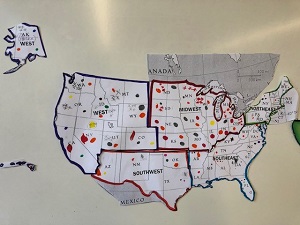Supporting Science through Interdisciplinary Instruction
By Korei Martin
Posted on 2019-02-19
The Next Generation Science Standards (NGSS) have totally transformed my students’ learning experiences in STEM. However, like most teachers, my biggest challenge has been finding the  additional time that students need to observe, question, investigate, and interpret results. Thinking and learning takes time. Interdisciplinary instruction within my elementary classroom provides authentic, relevant learning experiences that support the NGSS and my state’s learning standards for Math, English Language Arts, Social Studies, and 21st Century Skills.
additional time that students need to observe, question, investigate, and interpret results. Thinking and learning takes time. Interdisciplinary instruction within my elementary classroom provides authentic, relevant learning experiences that support the NGSS and my state’s learning standards for Math, English Language Arts, Social Studies, and 21st Century Skills.
During my Life Science Unit this year, my fourth graders were learning about the internal and external structures that support the growth and survival of animals. Students also learned about how an animal’s body structures were adaptations for the ecosystem(s) they live in. In Reading, my kids read about Christian the Lion and how he was affected by being kept as a pet. For those of you not familiar with the story, he was rescued and rehabilitated by two people who learned about his confinement. The text can be presented through Guided Reading, Shared Reading, or independently (depending on the needs of individual students). Students connected information from the text and discussed the needs of lions and other wild animals. From there, we moved into an Opinion writing piece about whether or not wild animals should be kept as exotic pets. My students had very strong opinions about this question. They worked with partners to research the pros and cons of keeping exotic pets. Then, they wrote their opinions and engaged in a spirited debate. In Math, students can create bar graphs to represent different exotic animals being kept as pets and then use that data to discuss the impact within ecosystems when those animals are taken out. The Social Studies connection includes research and discussion on the economic impact within specific countries from businesses that buy and sell exotic animals. As students  discover the range of reasons for the existence of this market, students naturally start discussing laws that either encourage or discourage this practice.
discover the range of reasons for the existence of this market, students naturally start discussing laws that either encourage or discourage this practice.
In another science lesson (Earth Science), students were learning about the effects of weathering, erosion, and deposition on the surface of the earth. Students read about the three processes (in small groups and independently), as well as natural disasters including hurricanes and earthquakes. The reading standards addressed were: identifying important information and note taking as well as informational text features and structures. The Social Studies connection including a focus on map reading skills. Students identified and researched natural disasters that occur in the United States. They placed events on a U.S. map and identified any patterns they noticed between the Earth’s surface and the location of particular events. As a culminating activity, students had to design and build an earthquake or hurricane resistant structure. They tested it, recorded the results, and redesigned when appropriate. The Math connection occurred during the design process as well as in the reflection process by identifying geometric shapes that provided the best stability.

Interdisciplinary instruction has years of research that support it. But, more importantly perhaps, is the observation that when I watch my students learn in this kind of environment they are able to transfer and apply their understandings from one subject to another. They quickly identify and discuss the connections with each other and learn to engage in argument based on evidence acquired across all subject areas. My advice is to take it slow. My lessons have evolved over the years as I’ve observed my students learn and reflected on it. As you get more comfortable making those connections, you’ll be able to add more to the instructional design. Have fun with it!
Author: Debbie Ericksen, 4th Grade Teacher, Adamsville Primary School, Bridgewater-Raritan RSD
Email: debe506@att.net OR dericksen@brrsd.k12.nj.us 
Twitter: @DebbieEricksen5
Social Media Tags: PAEMST, NCTM, NSF, @BRRSDAdamsville
Disclaimer: The views expressed in this blog post are those of the author(s) and do not necessarily reflect the official position of the National Science Teaching Association (NSTA).


